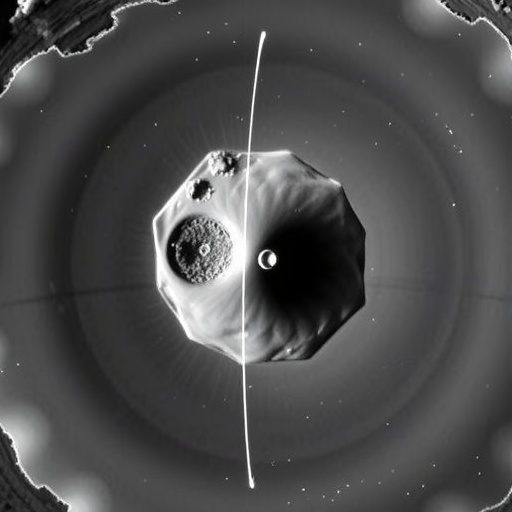In a groundbreaking revelation poised to redefine our understanding of the potential habitability of icy moons, scientists have unearthed a cache of complex organic molecules emanating from the subterranean ocean of Saturn’s enigmatic moon, Enceladus. This epochal discovery stems from an exhaustive reanalysis of data harvested by NASA’s Cassini spacecraft, which orbited Saturn and conducted multiple flybys of Enceladus between 2004 and 2017. The freshly identified organics provide compelling evidence of intricate chemical processes underway beneath the moon’s icy crust, elevating Enceladus as a prime candidate in the quest to find life beyond Earth.
Nearly two decades ago, Cassini made the extraordinary detection of towering jets of water vapor and ice particles gushing from fissures near Enceladus’s south pole, catapulting material from its hidden ocean directly into the vacuum of space. Initial studies established the presence of simple organic compounds within these plumes and the associated E ring of Saturn. However, these ice grains were aged, having been subjected to relentless space radiation, which potentially altered their chemical signatures. This limitation hampered scientists’ ability to directly probe the pristine chemistry of the ocean itself.
The breakthrough came when researchers turned their attention to a unique dataset collected during a daring 2008 flythrough of the freshly emitted plume by Cassini’s Cosmic Dust Analyzer (CDA). Unlike previous encounters with weathered particles, the CDA captured the smallest, most recently ejected ice grains—traveling at unprecedented velocities of approximately 18 kilometers per second. This higher impact speed was critical; it prevented water molecules from clustering and masking the signals of more subtle, complex organics.
Decoding these data required years of meticulous analysis and the application of refined techniques to distinguish the delicate signals of diverse organic fragments from the dominating water background. The results were nothing short of transformative. Detection of aliphatic chains, heterocyclic structures, esters, alkenes, ethers, and even nitrogen- and oxygen-bearing molecules pointed to a chemically rich environment. These classes of compounds are fundamental building blocks in terrestrial prebiotic chemistry that lead to the formation of biologically relevant macromolecules such as amino acids and nucleotides.
The implications of these findings extend beyond mere chemical inventory. They hint at active synthetic pathways operating within the Enceladus ocean, sustained potentially by hydrothermal processes at the ocean floor, where water-rock interactions create gradients of energy and chemically reactive compounds. Such conditions mirror essential features of early Earth environments thought to have nurtured the onset of life, suggesting that Enceladus’s ocean may be a habitable niche harboring the prerequisites for biology.
Furthermore, the identification of these molecules in freshly ejected ice confirms that the complex organics detected in the older, space-weathered grains of Saturn’s E ring are native to the ocean’s chemistry and not artifacts of surface or space processing. This revelation strengthens the premise that the moon’s subsurface ocean is an active chemical reactor with the capacity to generate intricate organics autonomously.
Experts involved in the study emphasize the broader significance of these discoveries. If Enceladus’s ocean chemistry produces prebiotic molecules naturally and abundantly, the likelihood increases that life as we understand it could originate or persist there. Equally compelling is the notion that even if life is absent, the mere presence of such a chemically dynamic environment underpins fundamental astrobiological inquiries concerning the distribution and rarity of life in the cosmos.
This treasure trove of data stands to guide the next chapter of exploration. The European Space Agency (ESA) is actively developing plans for an ambitious mission dedicated to orbiting and eventually landing on Enceladus. Such a mission would aim to sample the plume material directly and analyze surface deposits with sophisticated instrumentation tailored to uncover biosignatures and probe the moon’s habitability potential in unprecedented detail.
The new molecular discoveries also inform instrumental design, enabling mission planners to prioritize detectors and analytical techniques optimized for the suite of organics now known to exist. Direct sampling missions could resolve open questions about the ocean’s composition, energy sources, and potential bioavailability of organic compounds critical for life’s emergence and sustenance.
In a cosmic perspective, Enceladus exemplifies the tantalizing possibility of habitable niches beyond Earth’s warm embrace. It challenges preconceived notions that life requires surface liquid water liberally exposed to sunlight, showcasing that subsurface oceans beneath thick icy shells can harbor environments rich in chemical complexity and energetic disequilibria suitable for life.
As the scientific community eagerly anticipates future missions, the Cassini data legacy continues to flourish, demonstrating the unparalleled value of long-duration, high-quality space exploration endeavors. The rediscovery of complex organics in Enceladus’s freshest ice grains is not just a testament to ingenuity and perseverance but a beacon lighting the path toward understanding our place in a vast, potentially life-bearing universe.
With these revelations, Cassini’s impact resonates far beyond its operational lifetime. It propels Enceladus to the forefront of astrobiology and planetary science, promising exciting discoveries that could redefine our understanding of life’s potential beyond our home planet.
Subject of Research: Not applicable
Article Title: Detection of Organic Compounds in Freshly Ejected Ice Grains from Enceladus’s Ocean
News Publication Date: 1-Oct-2025
Web References:
https://dx.doi.org/10.1038/s41550-025-02655-y
References:
‘Detection of Organic Compounds in Freshly Ejected Ice Grains from Enceladus’s Ocean’ by N. Khawaja et al., published in Nature Astronomy
Image Credits: NASA/JPL-Caltech/Space Science Institute
Keywords: Enceladus, Saturn, Cassini spacecraft, organic molecules, astrobiology, icy moons, subsurface ocean, Cosmic Dust Analyzer, complex organics, habitable environment, planetary science, space exploration




